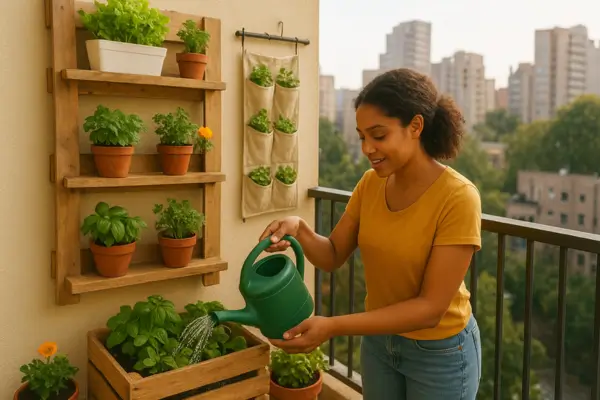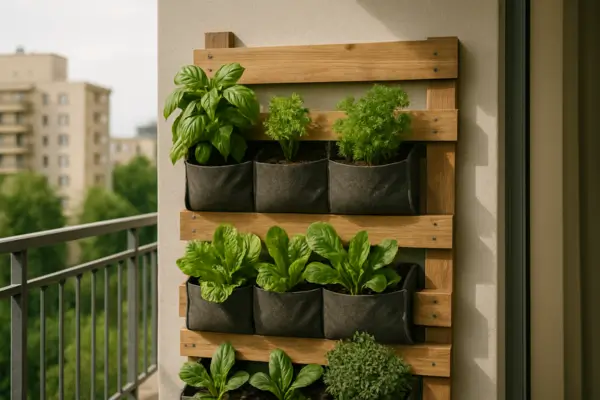Introduction
Living in a city doesn’t mean you have to give up on gardening. With vertical gardening, you can grow fresh herbs, vegetables, and flowers even in the smallest apartments or balconies. This innovative gardening method uses upward space instead of sprawling outward, making it perfect for urban dwellers with limited room.
Why Vertical Gardening is Ideal for Urban Spaces
- Saves Space: No backyard? No problem! Vertical gardens use walls, railings, and hanging structures to maximize growing area.
- Budget-Friendly: You don’t need expensive setups—repurposed containers, old pallets, and DIY solutions work great.
- Beginner-Approved: Even if you’ve never gardened before, vertical systems are simple to start and maintain.
What You’ll Learn in This Guide
In this article, we’ll cover:
✔ Low-cost materials to build your vertical garden
✔ Easy DIY setups using everyday items
✔ The best plants for beginners
✔ Maintenance tips to keep your garden thriving
✔ Common mistakes to avoid
Whether you have a tiny balcony, a sunny windowsill, or just a blank wall, vertical gardening lets you grow fresh, homegrown food and greenery without breaking the bank. Let’s dig in! 🌱
1-Why Choose Vertical Gardening?
If you’re an urban dweller with limited space but a growing desire to cultivate plants, vertical gardening is your perfect solution. This innovative approach lets you grow upwards instead of outwards, transforming even the smallest balcony, patio, or apartment wall into a thriving green oasis. Here’s why vertical gardening is a game-changer for city living:
1. Maximizes Limited Space
- No backyard? No problem! Vertical gardens utilize walls, railings, trellises, and hanging planters to grow plants upward, making them ideal for tight urban spaces.
- Perfect for apartment balconies, windowsills, or even indoor walls where traditional gardening isn’t possible.
2. Cost-Effective & Budget-Friendly
- Requires fewer materials than traditional gardens—no need for large plots of land or expensive raised beds.
- Many setups can be DIY’d using repurposed items like pallets, PVC pipes, shoe organizers, or recycled bottles.
- Saves money on groceries by growing herbs, greens, and veggies at home.
3. Enhances Urban Living
- Improves air quality by filtering pollutants and increasing oxygen levels.
- Adds natural beauty and tranquility to concrete-heavy environments.
- Can even insulate buildings and reduce urban heat effects when grown on exterior walls.
4. Low Maintenance & Easy Harvesting
- Compact designs mean less weeding and easier pest control.
- Plants at eye level make watering, pruning, and harvesting more convenient—no bending required!
- Great for beginners since many vertical-friendly plants (like herbs and leafy greens) are fast-growing and forgiving
Whether you want fresh herbs for cooking, homegrown salads, or just a touch of nature in your city home, vertical gardening offers a smart, space-saving, and affordable way to grow. Ready to start? Let’s explore how to build your own!
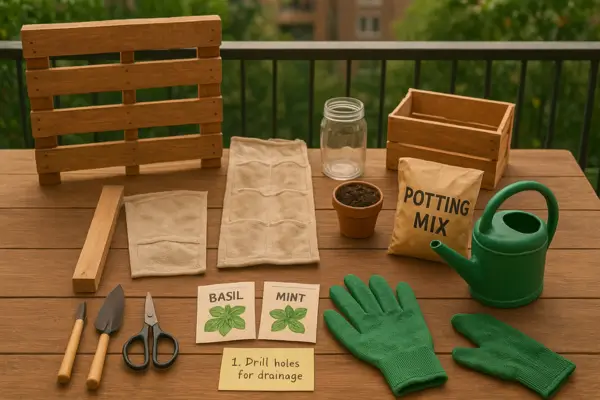
2- Essential Supplies for Low-Cost Vertical Gardening
Starting a vertical garden doesn’t require fancy equipment or a big budget. With some creativity and basic materials, you can build a thriving green space in even the smallest urban setting. Here’s everything you’ll need to get started:
1. Containers: Think Outside the (Planter) Box
You don’t need expensive pots—repurposed and upcycled items work perfectly:
- Plastic bottles & jars (cut horizontally or hung vertically)
- Wooden pallets (transform into rustic planters with minimal effort)
- Fabric shoe organizers (perfect for herbs and small greens)
- PVC pipes (drill holes to create a stacked tower garden)
- Gutter systems (ideal for shallow-rooted plants like lettuce)
Tip: Ensure containers have drainage holes to prevent waterlogging.
2. Soil: Keep It Light & Nutrient-Rich
Vertical gardens need well-draining, lightweight soil to avoid compaction:
- Budget-friendly potting mix (look for “container” or “potting” soil, not garden soil)
- DIY compost (mix kitchen scraps, leaves, and soil for a free, nutrient-dense option)
- Coconut coir or perlite (helps retain moisture without becoming soggy)
Avoid heavy garden soil—it can suffocate roots in vertical setups.
3. Plants: Start with Easy Wins
Choose low-maintenance, fast-growing plants that thrive in confined spaces:
- Herbs: Basil, mint, parsley, cilantro (grow quickly and need little space)
- Leafy greens: Lettuce, spinach, kale (harvest continuously)
- Compact veggies: Cherry tomatoes, peppers, bush beans (use trellises for support)
- Fruits: Strawberries (great for hanging planters)
- Flowers: Pansies, petunias (add color and attract pollinators)
Pro tip: Start with seedlings instead of seeds for faster results.
4. Supports: Stability is Key
Vertical gardens need sturdy structures to hold plants securely:
- Trellises (for climbing plants like peas or cucumbers)
- Wall-mounted racks or grids (attach planters or pots)
- Hooks & brackets (hang containers from ceilings or railings)
- Fishing line or twine (for lightweight support of vining plants)
Check weight limits—wet soil and plants can get heavy!
5. Watering System: Keep It Simple
Vertical gardens dry out faster than traditional ones, so efficient watering is crucial:
- Drip irrigation kits (affordable and automated)
- Self-watering planters (use reservoirs to reduce frequent watering)
- DIY wicking system (cotton ropes draw water from a bottle to roots)
- Spray bottles or watering wands (for gentle, targeted watering)
Water in the morning to prevent evaporation and mold growth.
Final Tip: Start Small & Expand
You don’t need everything at once—begin with one repurposed container, a bag of potting mix, and a few herb seedlings. As you gain confidence, add more layers and plants. Happy gardening! 🌿
Next up: DIY Vertical Garden Ideas for Beginners!
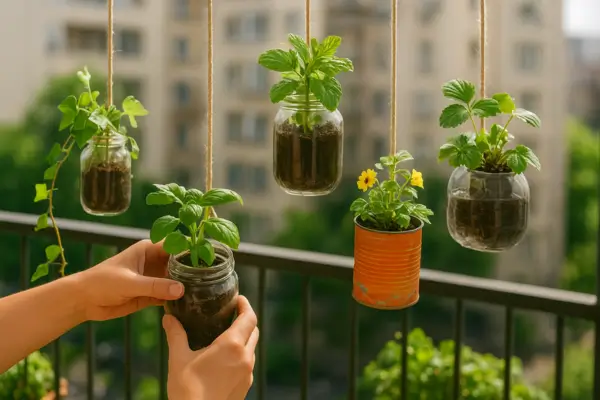
3- DIY Vertical Garden Ideas for Beginners
Ready to turn your small urban space into a lush green retreat? These easy, budget-friendly vertical garden ideas use everyday items to help you grow more in less space—no fancy tools required!
1. Hanging Planters from Recycled Jars & Cans
Perfect for: Herbs, small flowers, or trailing plants like strawberries
How to Make It:
- Collect clean glass jars, tin cans, or plastic bottles.
- Drill drainage holes in the bottom.
- Fill with soil and plant your herbs or flowers.
- Hang with ropes, chains, or hooks from a balcony rail, ceiling, or wall.
Pro Tip: Paint jars for a colorful touch, or group them at different heights for visual interest.
2. Pallet Gardens (The Ultimate Upcycle!)
Perfect for: Lettuce, herbs, succulents, or flowers
How to Make It:
- Find a clean, untreated wooden pallet (check local stores for free ones!).
- Line the back with landscape fabric to hold soil in place.
- Fill with potting mix between the slats.
- Plant small greens or herbs in the gaps.
- Lean against a wall or fence (or secure upright for stability).
Pro Tip: Start with shallow-rooted plants—deep-rooted veggies may struggle.
3. Pocket Planters from Shoe Organizers
Perfect for: Herbs, salad greens, or strawberries
How to Make It:
- Hang a fabric shoe organizer on a fence, balcony rail, or wall.
- Fill each pocket with soil (add perlite for drainage).
- Plant herbs like basil, mint, or parsley in the pockets.
- Water gently (the fabric helps wick moisture).
Pro Tip: Place taller plants at the top, trailing ones at the bottom.
4. Tower Gardens with Stacked Pots or Buckets
Perfect for: Strawberries, cherry tomatoes, or leafy greens
How to Make It:
- Stack pots or buckets in decreasing sizes (like a pyramid).
- Fill each layer with soil and plant your crops.
- Use a central PVC pipe with holes for easy watering (optional).
Pro Tip: Rotate the tower occasionally so all plants get even sunlight
Why These Work for Beginners:
✅ Super affordable (most materials are free or cheap!)
✅ Space-saving (grow more in tiny areas)
✅ Easy to adjust (move, expand, or change plants anytime)
Which one will you try first? Each of these projects can be set up in under an hour—so pick your favorite and start growing! 🌱
Next Up: The Best Plants for Vertical Gardens!
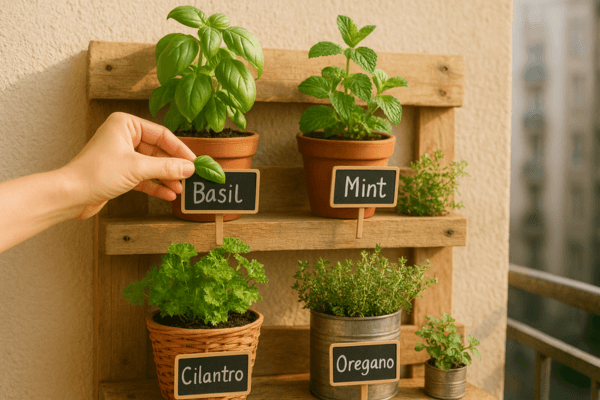
4- Best Plants for Vertical Gardens: Easy Picks for Beginners
One of the keys to successful vertical gardening is choosing the right plants. You’ll want varieties that thrive in confined spaces, grow quickly, and don’t require deep roots. Here are the best beginner-friendly plants for your vertical garden, categorized for easy selection:
1. Herbs (Low-Maintenance & Flavorful)
Perfect for small containers and frequent harvesting.
Top Picks:
🌿 Basil – Grows fast, loves sun, and thrives in pots.
🌿 Mint – Hardy and spreads quickly (best in its own container to prevent takeover).
🌿 Parsley – Cold-tolerant and great for beginners.
🌿 Cilantro – Quick-growing but bolts in heat; replant every few weeks.
🌿 Thyme & Oregano – Drought-resistant and perfect for vertical pockets.
Why They Work: Most herbs have shallow roots and adapt well to containers. Plus, you’ll always have fresh flavors for cooking!
2. Leafy Greens (Fast & Productive)
Ideal for continuous harvests in tight spaces.
Top Picks:
🥬 Lettuce (Butterhead, Romaine, Loose Leaf) – Grows in just 4-6 weeks; cut-and-come-again!
🥬 Spinach – Cool-weather favorite; plant in spring or fall.
🥬 Kale – Hardy and nutrient-packed; tolerates partial shade.
🥬 Swiss Chard – Colorful stems and long harvest window.
Why They Work: These greens grow quickly and don’t need deep soil, making them perfect for vertical planters or stacked systems.
3. Compact Veggies & Fruits (Small but Mighty)
Choose dwarf or bushy varieties for vertical success.
Top Picks:
🍅 Cherry Tomatoes (Bush or Dwarf Types) – Try ‘Tumbling Tom’ or ‘Micro Tom’ for hanging baskets.
🌶️ Peppers (Mini Bell or Chili Varieties) – Compact and prolific in containers.
🍓 Strawberries (Alpine or Everbearing) – Thrive in hanging planters or pocket gardens.
🥒 Bush Cucumbers – Look for “patio” or “spacemaster” types.
Why They Work: These plants produce well in confined spaces and can be trained up trellises or cages.
4. Flowers (For Beauty & Pollinators)
Add color and attract beneficial insects to your garden.
Top Picks:
🌸 Petunias – Trailing varieties like ‘Wave’ spill beautifully from hanging planters.
🌼 Marigolds – Pest-repellent and bright; great for companion planting.
🌺 Nasturtiums – Edible flowers that climb or trail; deter aphids.
🌷 Pansies – Cold-tolerant and perfect for vertical pockets.
Why They Work: Flowers brighten up urban spaces and help pollinate edible plants nearby.
Quick Tips for Picking Plants:
✔ Match plants to sunlight (herbs & tomatoes need 6+ hours; lettuce tolerates shade).
✔ Group plants with similar water needs (e.g., don’t pair thirsty lettuce with drought-tolerant thyme).
✔ Start small—pick 3-5 easy plants to avoid overwhelm.
Now that you’ve chosen your plants, it’s time to learn how to care for them!
Next Up: Maintenance Tips for a Thriving Vertical Garden! 🌱
5-Maintenance Tips for a Thriving Vertical Garden
Keeping your vertical garden healthy doesn’t have to be complicated. With the right care, your plants will flourish—even in small urban spaces. Here’s how to maintain lush, productive growth with minimal effort.
1. Watering: Keep Roots Happy (But Not Drowned)
Vertical gardens dry out faster than traditional ones, so smart watering is key.
Best Practices:
💧 Check soil daily—poke a finger in; if the top inch is dry, it’s time to water.
💧 Morning is best—reduces evaporation and prevents fungal diseases.
💧 Use a gentle flow—a watering can with a long spout or drip irrigation avoids soil disruption.
💧 Self-watering hacks:
- Wicking system (place a water-filled bottle upside down in the soil).
- Reservoir planters (containers with built-in water storage).
Avoid:
❌ Overwatering (soggy soil = root rot).
❌ Spraying leaves in hot sun (can scorch them).
2. Sunlight: Give Plants the Right Dose
Not all plants need the same light—placement matters!
Ideal Conditions:
☀️ Full sun (6+ hours): Tomatoes, peppers, basil, strawberries.
⛅ Partial sun (3–6 hours): Lettuce, kale, mint, parsley.
🌥️ Shade-tolerant (2–3 hours): Spinach, cilantro, ferns.
Pro Tips:
✔ Rotate containers weekly so all sides get light.
✔ Use reflective surfaces (white walls, foil) to bounce light onto plants.
✔ Monitor for scorching—if leaves yellow or crisp, move to shade.
3. Fertilizing: Feed Your Garden Naturally
Nutrients deplete faster in containers—replenish them!
Low-Cost Options:
🌱 Compost tea: Steep compost in water for 24 hours, then water plants.
🌱 Banana peel fertilizer: Soak peels in water for 3 days; use the potassium-rich liquid.
🌱 Eggshell powder: Crush dried shells for calcium (great for tomatoes!).
🌱 Worm castings: Mix into soil for slow-release nutrients.
How Often?
- Fast growers (lettuce, herbs): Every 2–3 weeks.
- Fruiting plants (tomatoes, peppers): Every 1–2 weeks.
4. Pest Control: Fight Bugs Naturally
Avoid chemicals—try these safe, effective methods instead.
Prevention & Remedies:
🐞 Neem oil spray: Mix 1 tsp neem oil + 1/2 tsp soap in 1L water; spray leaves weekly.
🐞 Companion planting:
- Marigolds repel aphids and nematodes.
- Basil deters mosquitoes and flies.
🐞 Manual removal: Pick off pests like caterpillars; blast aphids with water.
🐞 Garlic/chili spray: Blend with water, strain, and spray to deter bugs.
Watch For:
⚠️ Yellowing leaves (could signal overwatering or pests).
⚠️ Holes or sticky residue (check undersides of leaves for bugs).
Bonus: Seasonal Care
- Summer: Water more frequently; shade plants in heatwaves.
- Winter: Move frost-sensitive plants indoors; use cloches for protection.
Consistency is key! A little daily attention keeps your vertical garden thriving.
Next Up: Common Mistakes to Avoid—so you don’t learn the hard way! 🚫🌱
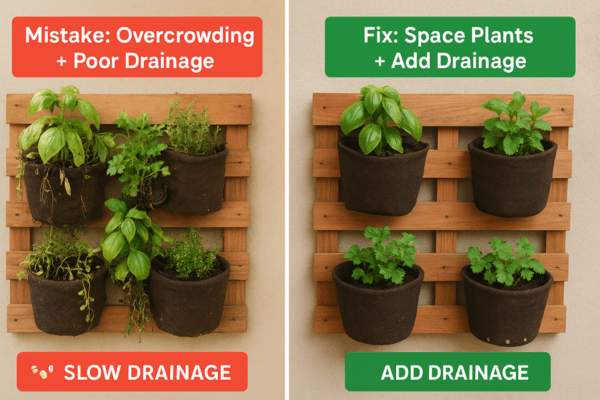
6-Common Vertical Gardening Mistakes (And How to Avoid Them)
Even the most enthusiastic urban gardeners can run into trouble with vertical planting. Here are the top mistakes beginners make—and simple fixes to keep your garden thriving.
1. Overcrowding Plants
The Problem:
Packing too many plants into a small space leads to:
➔ Stunted growth (competing for light and nutrients).
➔ Poor air circulation (increases mold and pest risks).
The Fix:
✔ Follow spacing guidelines (e.g., basil needs 6–8″ between plants).
✔ Use the “one plant per pocket” rule in shoe organizers or pallets.
✔ Prune regularly to prevent overcrowding.
2. Poor Drainage = Root Rot
The Problem:
Waterlogged soil suffocates roots and invites fungal diseases.
The Fix:
✔ Always drill drainage holes in containers (even in upcycled items!).
✔ Add perlite or sand to soil for better drainage.
✔ Elevate pots with pebbles or feet to let excess water escape.
Pro Tip: If roots smell musty or leaves yellow, repot immediately in fresh, dry soil.
3. Ignoring Sunlight & Spacing Needs
The Problem:
Plants stretch awkwardly or fail to thrive if placed wrong.
The Fix:
✔ Group plants by light needs:
- Full sun (6+ hours): Tomatoes, peppers, rosemary.
- Partial shade (3–6 hours): Lettuce, mint, parsley.
✔ Rotate containers weekly for even light exposure.
✔ Use trellises to direct vining plants (like peas) toward sunlight.
4. Using Low-Quality Soil
The Problem:
Heavy garden soil or cheap mixes compact in containers, starving roots of oxygen.
The Fix:
✔ Buy potting mix labeled for containers (lighter and fluffier).
✔ Enrich with compost for nutrients (DIY or store-bought).
✔ Refresh soil every season to prevent nutrient depletion.
Never Use:
❌ Dense garden soil (suffocates roots).
❌ Soil from old houseplants (may harbor diseases).
Bonus: 3 Quick Troubleshooting Tips
- Leggy plants? They need more light—move to a sunnier spot.
- Slow growth? Try liquid fertilizer (like diluted fish emulsion).
- Pests? Spray with soapy water or neem oil ASAP.
Avoid these pitfalls, and your vertical garden will reward you with lush growth!
Next Up: Creative ways to maximize small spaces—even renters can do it! 🌿
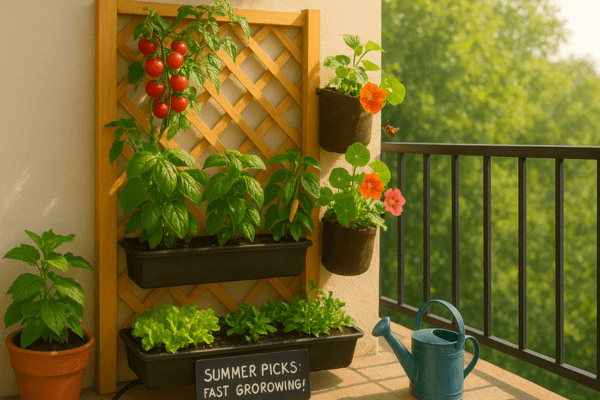
7-Seasonal Vertical Gardening: Year-Round Growing Tips
A thriving vertical garden adapts to the seasons. Whether you’re battling summer heat or winter chills, these tips will help you grow successfully all year long—indoors and out.
Spring/Summer: Maximize Growth in Warm Weather
Best Plants to Grow:
🌿 Heat-Lovers: Cherry tomatoes, peppers, basil, cucumbers, beans
🌿 Fast-Greens: Lettuce, arugula, spinach (harvest before bolting)
🌿 Trailing Flowers: Nasturtiums, petunias (attract pollinators)
Heat Management Tips:
☀️ Shade Cloth: Use 30-50% shade fabric to protect delicate greens from scorching.
💧 Water Deeply in Early Morning: Prevents evaporation and reduces heat stress.
🌬️ Improve Airflow: Space plants slightly wider to prevent fungal diseases.
❄️ Cool Roots: Mulch with straw or coconut coir to retain moisture.
Pro Tip: In heatwaves, move potted plants to afternoon shade.
Fall/Winter: Keep Growing in Cooler Weather
Cold-Resistant Plants:
❄️ Hardy Greens: Kale, Swiss chard, spinach, mustard greens
❄️ Herbs: Parsley, cilantro, thyme, oregano
❄️ Root Veggies: Radishes, green onions (shallow roots work in vertical setups)
Indoor Vertical Gardening Ideas:
🏠 Windowsill Herb Garden: Use hanging mason jars or wall-mounted planters.
💡 Grow Lights: LED strips or clip-on bulbs for dark apartments.
🌱 Microgreens: Grow nutrient-packed shoots in shallow trays on shelves.
Outdoor Winter Protection:
🧤 Frost Blankets: Cover plants on freezing nights (use clothespins to secure).
🛡️ Insulate Containers: Wrap pots in bubble wrap or burlap.
🌧️ Avoid Overwatering: Wet soil + cold = root rot. Water only when dry.
Extreme Weather Protection
Wind:
🌀 Secure Trellises: Anchor with heavy weights or zip-ties.
🌀 Choose Sturdy Plants: Bush beans, dwarf peas, and thyme handle wind better than delicate lettuces.
Heavy Rain:
☔ Angle Containers Slightly: Prevents waterlogging.
☔ Add Extra Drainage Holes: Prevents soil from washing out.
Frost/Snow:
❄️ Move Pots Indoors Overnight: Even cold-tolerant plants appreciate shelter.
❄️ Cluster Plants Together: Creates a microclimate of slightly warmer air.
Seasonal Checklist
| Season | To-Do List |
| Spring | Start seeds indoors; set up trellises; plant cool-weather crops. |
| Summer | Water daily; harvest frequently; shade tender plants. |
| Fall | Sow cold-hardy greens; prep indoor setups; mulch containers. |
| Winter | Use grow lights indoors; cover outdoor plants; reduce watering. |
With a little seasonal tweaking, your vertical garden can produce fresh food and beauty 365 days a year!
Next Up: Creative ways to maximize tiny spaces—perfect for renters! 🏙️🌿
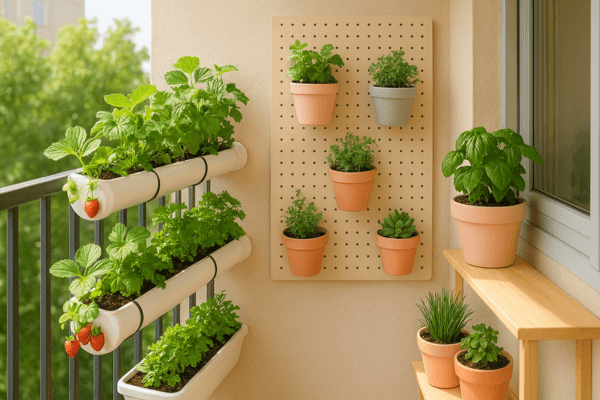
8-Space-Saving Hacks: Vertical Gardening in Tiny Urban Areas
Living in a small apartment or rental doesn’t mean you can’t have a thriving garden. With clever design and a bit of creativity, you can transform every inch of your space into a lush, productive oasis. Here’s how to maximize your vertical growing potential—no yard required!
1. Utilize Every Surface: Balcony Rails, Walls & Windowsills
Balcony Rail Planters
- Hanging baskets or rail-mounted boxes for herbs, strawberries, or flowers.
- DIY hack: Repurpose gutters or PVC pipes as shallow planters attached with zip ties.
Wall-Mounted Gardens
- Pegboard planters: Use hooks to hang small pots or mason jars.
- Felt pocket panels: Stylish and perfect for herbs like mint or thyme.
Windowsill Gardens
- Stacked shelves for potted herbs (basil, parsley, chives).
- Suction cup planters for apartments with no balcony.
Pro Tip: Use lightweight plastic or fabric containers to avoid overloading structures.
2. Blend Gardening with Home Décor
Living Wall Art
- Frame-mounted air plants or succulents as a living picture.
- Geometric wall planters for a modern, stylish touch.
Functional Green Dividers
- Hanging macramé planters to separate spaces while adding greenery.
- Bookshelf gardens with trailing plants like pothos or philodendron.
Kitchen Herb Displays
- Magnetic spice racks repurposed for small herb pots.
- Tiered plant stands near sunny windows for cooking-ready herbs.
Design Bonus: Match pots to your color scheme for a cohesive look.
3. Modular & Movable Setups for Renters
Freestanding Vertical Systems
- Ladder gardens: Lean a wooden ladder against a wall and place plants on the rungs.
- Rolling plant carts: Move your garden to follow sunlight.
Temporary & Non-Invasive Solutions
- Command hooks + hanging planters: No nails or damage to walls.
- Fabric shoe organizers: Hang over doors or balcony rails (easy to remove).
Stackable & Collapsible Designs
- Foldable pallet planters: Break down when moving.
- Tiered stacking pots: Expand or condense as needed.
Renter-Friendly Tip: Always check lease rules before drilling—many setups work without permanent changes!
Quick Space-Saving Ideas
✔ Hang plants from ceiling hooks (great for trailing varieties).
✔ Use the back of doors with over-the-door organizers.
✔ Opt for dwarf or “patio” varieties of veggies and fruits.
Final Thought: You don’t need a backyard—just a little ingenuity! Whether it’s a tiny balcony, a sunny window, or a blank wall, there’s always a way to grow fresh, homegrown goodness.
Now, over to you—which space will you transform first? 🌿
Next Up: Conclusion & final tips to kickstart your vertical garden!
Conclusion:
Start Your Vertical Gardening Journey Today!
Vertical gardening is more than just a trend—it’s a smart, sustainable, and space-saving solution for urban dwellers who crave fresh greens but lack traditional garden space. Let’s recap why this approach is a game-changer:
Why Vertical Gardening Wins
✔ Saves Space: Grow food and flowers without a backyard—just use walls, rails, or windows!
✔ Budget-Friendly: Repurpose everyday items like pallets, shoe organizers, or bottles for low-cost setups.
✔ Beginner-Approved: Easy-to-grow plants like herbs, lettuce, and strawberries offer quick wins.
✔ Year-Round Potential: With simple seasonal adjustments, you can grow indoors or outdoors in any climate.
Your Next Steps
- Start Small: Pick one easy project (like a hanging herb jar or shoe organizer garden).
- Experiment: Not every plant will thrive—and that’s okay! Learn as you grow.
- Expand Gradually: Add more layers, plants, or systems as you gain confidence.
Join the Conversation!
We’d love to see your creations or help troubleshoot:
- Share a photo of your vertical garden in the comments!
- Ask questions if you’re stuck—our community loves to help.
Remember: Every lush green wall or overflowing herb planter started with a single seed. Yours can too! 🌱

